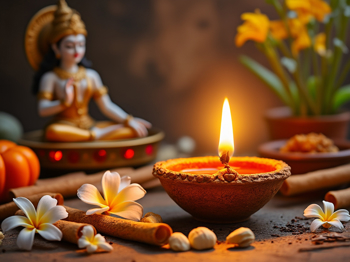The significance of the Kaalsarp Dosh Nivaran Puja lies in its ability to mitigate the adverse effects of the Kaalsarp Dosh in one's horoscope. According to Vedic astrology, this dosh can cause delays, struggles, and turmoil in various aspects of life, including health, career, finances, and relationships. By performing this puja, devotees seek to appease Rahu and Ketu, the shadow planets responsible for this dosh, and invoke the blessings of Lord Shiva. The ritual is believed to bring peace, prosperity, and balance into the lives of those affected, helping them to lead a more harmonious and successful life.
- Mitigation of Negative Influences: The puja helps in reducing the negative impact of Kaalsarp Dosh, bringing relief from constant obstacles and challenges in life.
- Improvement in Health: Performing the puja is believed to help in overcoming health issues that may be caused by the dosh.
- Enhancement of Career and Financial Stability: The ritual is thought to remove hurdles in professional life, leading to career growth and financial stability.
- Harmonious Relationships: The puja can help in resolving conflicts and improving relationships within the family and with others.
- Spiritual Growth: The ceremony aids in spiritual development by invoking divine blessings, bringing peace and contentment to the mind and soul.
- Protection from Evil Influences: It provides protection from evil spirits, negative energies, and malefic planetary effects, ensuring overall well-being.
- Overall Prosperity and Success: By removing the dosh, the puja opens the doors to success, prosperity, and a more balanced life.
The Kaalsarp Dosh Nivaran Puja is a Hindu ritual performed to mitigate the effects of the Kaalsarp Dosh, a condition in one's horoscope that is believed to bring negative energy and obstacles in life. Below is a step-by-step guide on how this puja is typically performed:
1. Consultation with an Astrologer
- Before performing the puja, consult a knowledgeable astrologer to confirm the presence of Kaalsarp Dosh in your horoscope and to determine the appropriate time (muhurat) for the puja.
2. Selecting the Location
- The puja is most commonly performed at holy places like Trimbakeshwar in Nashik, Ujjain, or in Kalahasti Temple. However, it can also be performed at other holy places or in your home with the guidance of a priest.
3. Choosing the Muhurat
- The astrologer will suggest an auspicious time and date based on your horoscope and the positions of the planets. This is usually performed on Panchami, Amavasya, or on a Sunday or Tuesday.
4. Preparations for the Puja
- Fasting: The person for whom the puja is being performed should observe a fast (upavasa) from the night before the puja.
- Puja Samagri: Gather all the necessary items for the puja, including flowers, fruits, betel leaves, incense sticks, lamps, turmeric, vermillion (kumkum), rice, black sesame seeds, a copper or brass pot (kalash), and a snake idol or image.
5. Arriving at the Temple or Setting up at Home
- Arrive at the temple or prepare the area in your home where the puja will be conducted. Cleanse the area thoroughly.
6. Purification Rituals
- Achamana: The priest will guide you through a purification ritual where you will sip water three times while chanting specific mantras.
- Pranayama: Perform breathing exercises to center yourself.
- Sankalpam: Make a vow or intention (sankalp) stating the purpose of the puja.
7. Invocation of Deities
- The priest will invoke Lord Ganesha first to remove obstacles. Then, prayers are offered to the main deities associated with the puja, including Lord Shiva, Goddess Parvati, and the nine planets (Navagrahas).
8. Main Kaalsarp Dosh Nivaran Puja
- Kalash Sthapana: A copper or brass pot filled with water and adorned with mango leaves and a coconut is placed near the deity's idol.
- Sarpa Puja: A snake idol (representing the serpent gods) is placed and worshipped. Mantras are chanted to appease the serpent gods and remove the negative effects of the Kaalsarp Dosh.
- Abhishekam: Perform abhishekam (ritual bathing) of the Shiva Linga with water, milk, honey, and other sacred items.
- Offering of Naivedyam: Offer fruits, sweets, and other food items to the deity.
- Homa (Havan): A sacred fire ritual is performed where specific offerings (havan samagri) are made while chanting mantras. This helps in purifying the environment and the soul.
9. Recitation of Mantras
- Recite the following mantras during the puja:
- Kaalsarp Mantra
- Maha Mrityunjaya Mantra
- Navagraha Mantra
- The priest may also recite the Rahu and Ketu stotras (hymns).
10. Pradakshina
- After the puja, perform circumambulation (pradakshina) around the deity or temple seven times.
11. Purnahuti
- The final offering (purnahuti) is made into the sacred fire, and blessings are sought from the deities.
12. Visarjan
- The idol of the snake or the symbolic items used in the puja are immersed in a river or flowing water, symbolizing the end of the ritual.
13. Donation and Feeding
- Donate to the poor and feed Brahmins or the needy as per your capacity. This is believed to add to the merit of the puja.
14. Concluding the Puja
- The priest will conclude the puja with a final aarti, and you will receive the prasadam (blessed food) and holy water.
15. Breaking the Fast
- After the completion of the puja, you may break your fast by consuming the prasadam.
16. Post-Puja Guidelines
- The priest may give you specific guidelines to follow after the puja, such as avoiding non-vegetarian food and alcohol for a certain period or maintaining a peaceful state of mind.
By following these steps, you can successfully perform the Kaalsarp Dosh Nivaran Puja and seek relief from the negative effects associated with this dosh.




